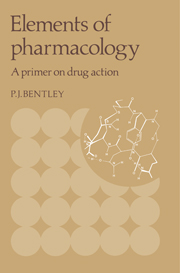Book contents
- Frontmatter
- Contents
- Preface
- 1 Introduction
- 2 Scope of pharmacology
- 3 Where do drugs come from?
- 4 The names of drugs
- 5 Techniques and methods of pharmacology
- 6 Absorption, distribution, and elimination of drugs; pharmacokinetics
- 7 The nature of responses to drugs
- 8 Receptor theory
- 9 Relationship of chemical structure to biological activity
- 10 Roles of the cell membrane in responses to drugs
- 11 Clinical aspects of the actions of drugs
- 12 Conclusion
- References
- Glossary of drugs named in the text
- Index
7 - The nature of responses to drugs
Published online by Cambridge University Press: 29 January 2010
- Frontmatter
- Contents
- Preface
- 1 Introduction
- 2 Scope of pharmacology
- 3 Where do drugs come from?
- 4 The names of drugs
- 5 Techniques and methods of pharmacology
- 6 Absorption, distribution, and elimination of drugs; pharmacokinetics
- 7 The nature of responses to drugs
- 8 Receptor theory
- 9 Relationship of chemical structure to biological activity
- 10 Roles of the cell membrane in responses to drugs
- 11 Clinical aspects of the actions of drugs
- 12 Conclusion
- References
- Glossary of drugs named in the text
- Index
Summary
A drug ultimately acts to increase or decrease the activities of organs and cells. Such effects may be manifested in various ways, such as:
The contraction or relaxation of a muscle
An increase or decrease in the synthesis or release of a secretion (either exocrine or endocrine)
The uptake or loss of an ion (e.g., Na+, K+, Ca2+) or metabolic substrate (e.g., a sugar, amino acid, or fatty acid)
The formation, activation, or degradation of an intracellular metabolite (e.g., cyclic AMP or GMP) or enzyme (e.g., RNA polymerase, adenyl cyclase, Na-K ATPase)
A change in the rate of growth, maturation, and division of cells
Such physiological processes are complex and invariably involve a number of sequential, but distinct, steps, each of which may provide a possible locus for interference by a drug. The responses are also usually dependent on the general integrity of the cell, so that an action of drugs on one type of process may indirectly influence another.
General requirements of a drug
A drug has several required general properties, which are dictated by its physicochemistry and the properties of its target tissues.
It should exhibit a propensity to react preferentially at certain tissue sites. This characteristic gives it a selectivity so that it can exert effects that are sufficiently specific to make it useful. Its side effects and toxicity are thus limited.
An ability to act at relatively low concentrations is usually desirable.
[…]
- Type
- Chapter
- Information
- Elements of PharmacologyA Primer on Drug Action, pp. 40 - 43Publisher: Cambridge University PressPrint publication year: 1981



